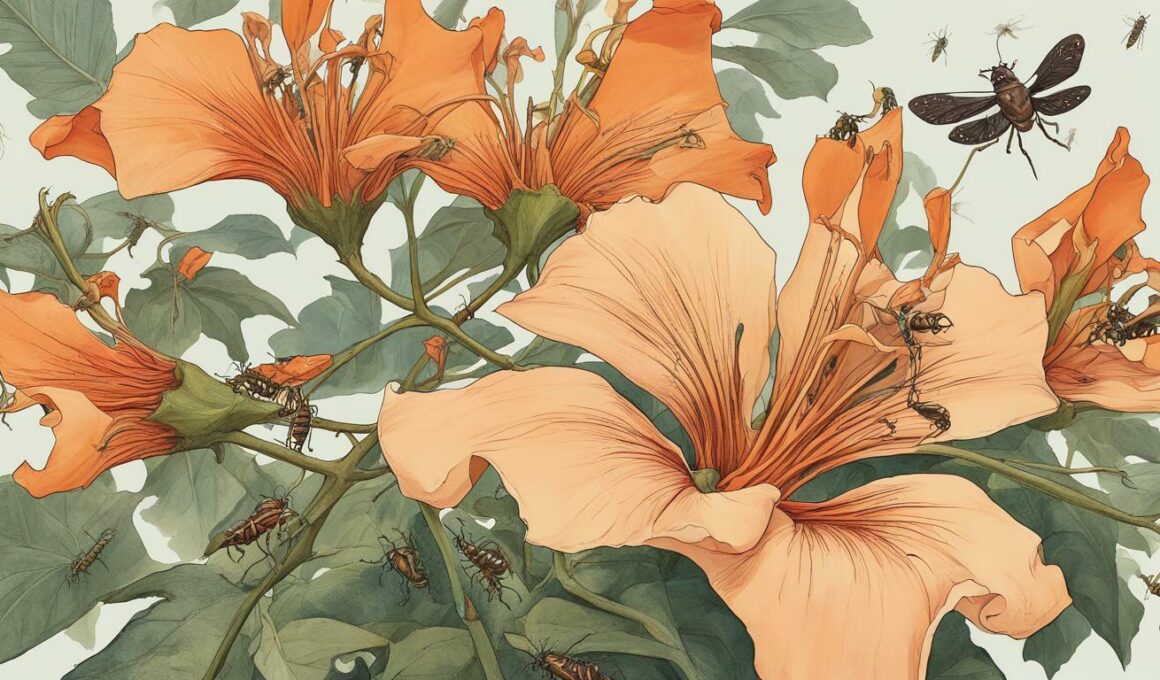If you’re a fan of trumpet vine flowers, you may have noticed some unwelcome visitors. These beautiful blossoms can be a target for pests and insects, leading to unsightly damage or even death. But never fear, there are ways to prevent and treat the damage. In this section, we will explore the common pests that attack trumpet vine flowers and discuss effective ways to prevent damage.
Post Summary:- Trumpet vine flowers are often targeted by pests and insects.
- Preventing damage requires understanding the common pests and their behavior.
- Effective prevention methods include both natural remedies and chemical options.
Identifying Common Pests of Trumpet Vine Flowers
Trumpet vine flowers are irresistible to a variety of insects and pests, which can cause damage to the plant if left unchecked. Here are some common pests to watch out for:
| Pest | Appearance and Behavior | Damage |
|---|---|---|
| Aphids | Small, soft-bodied insects that come in various colors. They cluster on new growth and leave behind sticky residue. | Distorted growth, yellowing leaves. |
| Leafhoppers | Small, wedge-shaped insects that jump when disturbed. They have a wide range of colors and patterns. | Yellow stippling on leaves, leaf curling, stunted growth. |
| Spider Mites | Small, arachnid-like pests that are difficult to see without a magnifying glass. They thrive in hot and dry conditions and spin webs on the plant. | Yellowing leaves, webbing on plant, defoliation. |
These pests can quickly multiply and cause significant damage to your trumpet vine flowers. Regular monitoring and prompt action can help prevent and control infestations.
Identifying Common Pests of Trumpet Vine Flowers
“Aphids and spider mites are two of the most common pests that attack trumpet vine flowers, but leafhoppers can also cause significant damage if not dealt with properly.”
You can identify these pests by closely examining your plants for signs of infestation. Look for clusters of aphids, jumping leafhoppers, or the fine webbing of spider mites. It’s also helpful to use a magnifying glass to get a closer look.
If you suspect an infestation, take action quickly to prevent the pests from spreading to other plants in your garden. There are a variety of natural and chemical remedies that can help control these pests and protect your trumpet vine flowers.
Understanding the Causes of Trumpet Vine Flower Damage
Trumpet vine flowers are susceptible to damage from various factors that can affect their growth and health. Identifying the causes of damage can help you take appropriate measures to protect and care for your plants.
| Cause | Description |
|---|---|
| Extreme weather conditions | High temperatures, drought, or excessive rainfall can stress the plant and cause damage to leaves and flowers. |
| Nutrient deficiencies | Insufficient levels of essential nutrients, such as nitrogen, phosphorus, or potassium, can weaken the plant and make it more vulnerable to pests and diseases. |
| Improper care | Failure to provide adequate watering, pruning, or support can cause stress and damage to the plant, making it more susceptible to pests and diseases. |
Correcting these issues can help prevent damage to your trumpet vine flowers. Ensure your plants receive adequate water and sunlight, and regularly fertilize the soil with the appropriate nutrients. Proper pruning and support structures can also promote healthy growth and reduce the risk of damage.
Natural Remedies for Protecting Trumpet Vine Flowers
Protecting trumpet vine flowers from pests and damage can be done effectively using natural remedies and prevention methods. These options are not only eco-friendly but also safe for both the plants and the environment. Here are some natural solutions to safeguard your trumpet vine flowers:
Companion Planting
One of the ways to keep pests at bay is to plant companion plants that repel harmful insects and beneficial insects that prey on them. Marigolds, garlic, and mint are some examples of companion plants that can protect trumpet vine flowers from pests. You can also attract beneficial insects such as ladybugs and lacewings to your garden by planting flowers like daisies and cosmos, which they love.
Organic Sprays
You can make your organic spray using simple ingredients like baking soda, neem oil, or insecticidal soap. These sprays can be used to deter and kill pests like aphids, whiteflies, and spider mites. Neem oil spray, for example, can also prevent fungal diseases and boost plant immunity. Mix the ingredients in a spray bottle and apply it to the affected parts of the trumpet vine flowers. Always read the instructions carefully and test a small area before spraying the whole plant.
Manual Control
One of the simplest methods of controlling pests is by manually removing them. Inspect the trumpet vine flowers regularly and pick off any pests that you see, such as caterpillars or beetles. You can also use a strong jet of water to blast off small insects like aphids, thrips, and mites from the leaves and flowers.
Cultural Practices
Proper cultural practices can also contribute significantly to preventing damage to trumpet vine flowers. For example, pruning the trumpet vine plant can help remove diseased or infested branches, allowing better air circulation and light penetration. Additionally, cleaning up fallen leaves and debris can decrease the likelihood of diseases and pests finding a home in the garden.
By implementing these natural remedies and methods, you can keep your trumpet vine flowers healthy and free from pests and damage, without any harm to the environment. Practice these techniques to enjoy a season full of beautiful blooms.
Chemical Options for Controlling Trumpet Vine Flower Pests
When natural remedies don’t suffice, chemical options may be necessary to control trumpet vine flower pests. Here are some options to consider:
| Chemical Treatment | Description |
|---|---|
| Insecticides | These can be used to kill and repel common pests, such as aphids and leafhoppers. Choose a product labeled for use on trumpet vine flowers and follow instructions carefully. |
| Fungicides | These can be applied to prevent or treat fungal diseases that affect trumpet vine flowers. Again, choose a product specifically labeled for this plant and follow instructions. |
| Systemic Treatments | These are chemicals that are absorbed into the plant’s system and provide long-lasting protection against pests and diseases. However, they can be harmful to beneficial insects and require careful handling. |
Before using any chemical treatment, carefully read the label and follow all safety precautions. Wear protective clothing and avoid applying in windy or rainy conditions. Always use chemicals as a last resort and consider their impact on the environment.
In addition to chemical treatments, there are other prevention measures you can take to avoid pest problems in the first place. Keep your trumpet vine flowers healthy and strong with proper care and maintenance, including regular watering, pruning, and fertilizing. Monitor for signs of pests and diseases and act quickly to prevent further damage.
Creating a Favorable Environment for Trumpet Vine Flowers
Trumpet vine flowers thrive in warm, humid conditions, but they can also adapt to cooler climates. Here are some tips on how to create a favorable environment for your plants:
Proper Watering
Water your trumpet vine flowers regularly, especially during periods of drought. Ensure the soil is moist but not overly saturated, as this can lead to root rot. A good rule of thumb is to water deeply once a week.
Soil Preparation
Trumpet vine flowers prefer well-draining soil that is rich in organic matter. Prior to planting, amend the soil with compost or aged manure to improve its texture and fertility.
Regular Maintenance
Maintain your trumpet vine flowers by removing dead leaves, spent flowers, and damaged branches. Regular pruning will encourage healthy growth and prevent overcrowding.
Provide Adequate Support Structures
Trumpet vine flowers are vigorous climbers and require sturdy support structures, such as trellises, arbors, or fences. Ensure the support structure is securely anchored and can withstand the weight of the plant.
Monitor for Signs of Pest or Diseases
Regularly inspect your trumpet vine flowers for signs of pests or diseases, such as leaf spots, wilting, or yellowing leaves. Early detection can help prevent damage to your plants and reduce the risk of spreading to neighboring plants.
By implementing these tips, you can create a favorable environment for your trumpet vine flowers, promoting their health and well-being.
Can Trumpet Vine Flowers Cause a Rash?
trumpet vine rash: facts & tips. Trumpet vine flowers are beautiful, but they can cause a rash for some individuals. The sap contains chemicals that irritate the skin, leading to an itchy and uncomfortable rash. If you come into contact with trumpet vine flowers, wash the area thoroughly and apply a soothing lotion to alleviate the symptoms.
Additional Tips for Trumpet Vine Flower Care
Aside from preventing pests and damage, there are other tips to keep your trumpet vine flowers healthy and beautiful. Here are some practices to consider:
- Pruning: Regular pruning of dead or diseased branches will promote new growth and prevent the plant from becoming too dense. Prune in late winter or early spring.
- Providing support: Trumpet vine flowers are vigorous climbers and need a sturdy support structure. Provide trellises or fences for the vines to climb on.
- Monitoring: Keep an eye out for signs of pests or diseases, such as yellow leaves, wilting, or discoloration. Early detection and treatment can prevent damage or spread.
By following these additional tips along with pest prevention measures, you can ensure your trumpet vine flowers thrive and bring joy to your garden or landscape.
Conclusion
By taking the time to understand the pests and environmental factors that can damage your trumpet vine flowers, you can take proactive steps to prevent and remedy any issues. Consider natural remedies, such as companion planting and organic sprays, before turning to chemical options. Always follow safety precautions when using chemicals and be sure to create a favorable environment for your plants by providing proper care and maintenance. By implementing these tips and techniques, you can enjoy the full beauty and health of your trumpet vine flowers all season long.
Can Bees Eating Trumpet Vine Flowers Cause Damage?
Bees are attracted to trumpet vines for their nectar, but their consumption of the flowers does not cause damage. In fact, bees play a crucial role in pollinating the trumpet vine flowers, aiding in the plant’s reproduction. Additionally, their activity benefits the ecosystem by supporting the local bee population.
FAQ
Q: What are some common pests that attack trumpet vine flowers?
A: Common pests that attack trumpet vine flowers include aphids, leafhoppers, and spider mites.
Q: What kind of damage do these pests cause?
A: These pests can cause damage such as leaf distortion, discoloration, and reduced flower production.
Q: How can I prevent damage to my trumpet vine flowers?
A: To prevent damage, you can implement natural remedies such as companion planting and attracting beneficial insects. Regular monitoring and proper care, including watering and soil preparation, are also important.
Q: What are some chemical options for controlling trumpet vine flower pests?
A: Chemical options for controlling pests include insecticides and fungicides. It is important to follow safety measures and consider the potential impact on beneficial insects and the environment.
Q: How can I create a favorable environment for trumpet vine flowers?
A: To create a favorable environment, ensure proper watering, soil preparation, and regular maintenance. Provide adequate support structures and monitor for signs of pests or diseases.
Q: Any additional tips for trumpet vine flower care?
A: Additional tips include practicing proper pruning techniques and monitoring for signs of pests or diseases. These practices contribute to the overall health and well-being of your trumpet vine flowers.









